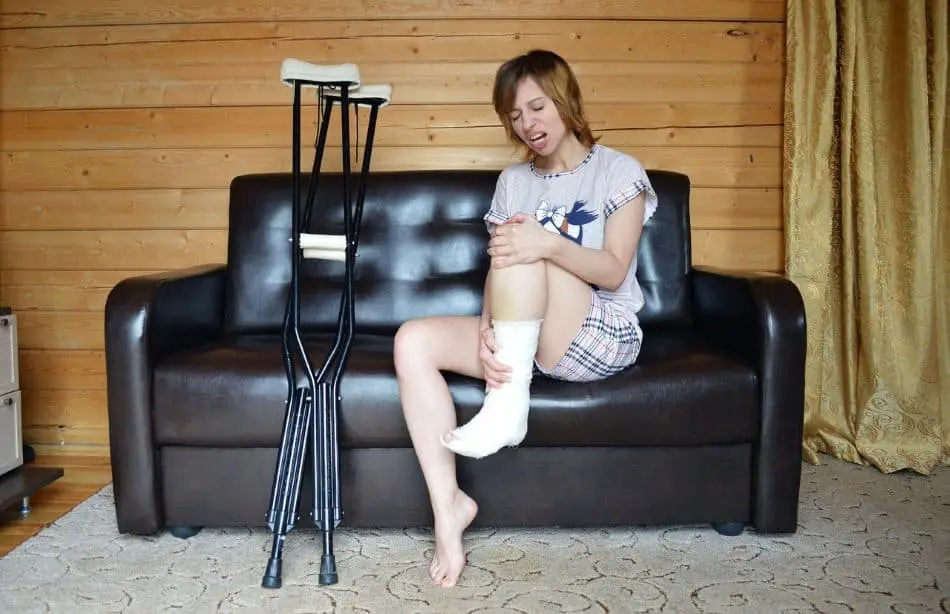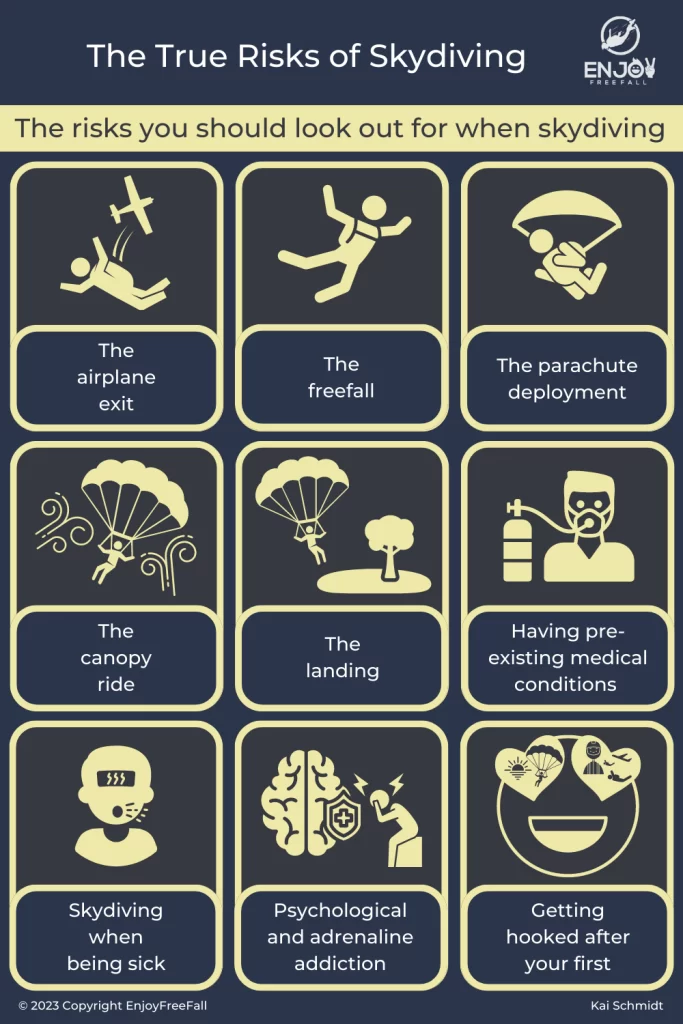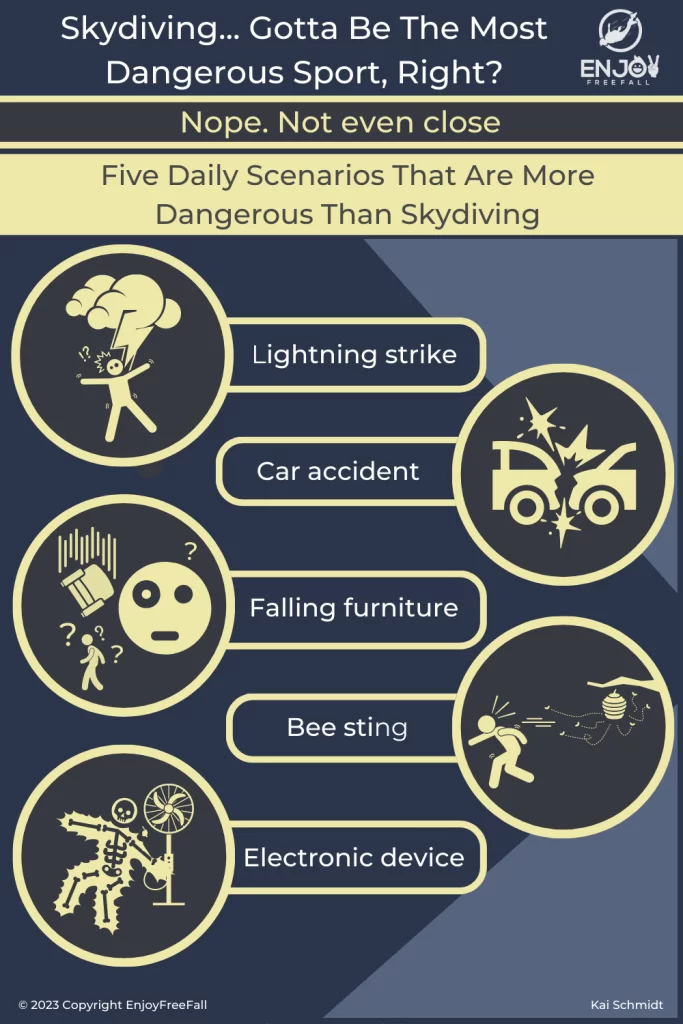
Skydiving is a scary activity because people jump from 15,000ft and rely on the parachute – basically a specialized piece of nylon – to arrive safely at the ground. On the contrary, you might have heard that skydiving is safer than driving. To clear the myths around skydiving safety, here are the true risks of skydiving.
The risk of dying on a solo skydive is around 0.00045% and only 0.00020% on a tandem skydive. Injury rates, however, are higher and range between 0.3 – 0.7% depending on the level of expertise of the skydiver. Most common injuries include sprained ankles, broken legs, and little bone fractures.
Many people think that parachute malfunction poses the greatest risks for skydivers, however, nothing could be farther from the truth. Almost every injury or fatality in skydiving is caused by human error.
The Risks and Most Common Sources Of Skydiving Injuries
Skydiving injuries happen around one in every 130 – 240 jumps depending on the experience of the skydivers. In general, novice skydivers are more likely to get injured during skydiving.
Specifically, when novice skydivers get more and more used to the dangers involved, they might get a little bit sloppy during their jumps. If skydivers make it through this “valley of death” they become more experienced and routinized and are less likely to make any mistakes.
In order to understand the risks of injuries during skydiving let’s go through the typical skydiving process.
The Risks During the Airplane Exit When Skydiving
One of the most underrated risks occurs when exiting the airplane. If you are not careful, you might bump your head at the airplane when you jump out of it. Hitting your head is rarely fatal, however, it is a bad start in the skydive.
It might lead to a temporary loss of orientations such that the skydiver is not sure which direction is up and which one is down. As a result, it is more difficult for skydivers to stabilize themselves in freefall and to deploy the parachute properly. If a skydiver loses his orientation, he will also be less likely to watch out for other skydivers.
At the very best, bumping your head is just a bad start for your skydive and an annoying feeling for the rest of the jump. One of the reasons why skydivers wear helmets is, in fact, to avoid this experience and prevent any serious head injuries such as concussions. Read my article here where I talk about the importance of skydiving helmets and factors to consider when buying one.
It is very unlikely to hit one’s own head during a tandem jump. The tandem instructor usually sits at the edge of the door of the aircraft with the students on his knees. He does not actively jump out of the airplanes but just falls over forward. As a result, almost no tandem students hit their heads.
The Risks During Freefall When Skydiving
As there are almost no other objects in the air, one might think that skydivers can not be injured during freefall. However, one of the most common sources of injuries is the collision between two skydivers. Specifically, when beginners jump, they might not observe their environment accordingly or might not be able to track away from other jumpers in time.
Skydivers also need to make sure never to be in the air above another skydiver. If the skydiver below changes his position from a head-down position to a belly-facing-earth position, he will decelerate quickly and the skydiver above might bump into him. Another risk occurs if the skydiver below accidentally opens his parachute – the skydiver above might not have the necessary time to avoid him.
Since the development of automatic deployment devices, freefall collisions almost never result in fatalities. Even if a skydiver is knocked unconscious, the parachute will be deployed automatically. However, the landing is likely to be uncontrolled and offside the dropzone which can result in severe injuries like back injuries, twisted ankles, and dislocations.
However, skydivers can also injure themselves during the collision specifically since both skydivers can reach speeds between 100 – 180 mph.
Skydiving collisions often happen either due to unintentional/ early parachute deployment or during formation jumps (or a combination thereof). During formation jumps the skydivers have close proximity to each other which makes them more likely to collide. They are also more prone to changes in wind speed and wind direction.
Since formation jumpers often wear weight bellies such that everyone has the same weight they will have the same falling speed. If two skydivers collide at a similar speed, the impact is limited and therefore the injuries are less severe.
The risk of collision is much lower for tandem skydives. The skydiving companies often make sure that there is enough time between each jump such that there is enough space between the tandem skydivers. Tandem instructors are also extremely experienced and will not make the mistake of flying over other skydivers or coming too close to them.
If you want to learn more about why tandem instructors can ensure a safe jump, check out my article about the requirements to become a tandem instructor! It demystifies the job and will make you feel much safer during your next tandem jump!
Besides collisions, the strong air resistance can dislocate the shoulders of skydivers if they move their arms in the wrong position. However, dislocating one’s shoulders normally happens to people that have dislocated their shoulders before and are not able to withstand so much pressure on them.
Have you ever wondered how skydivers maneuver their bodies during freefall and safely navigate back to the ground? While it may look effortless, skydiving requires precise control and technique to achieve the desired outcomes. In this blog post, I delve into the different maneuvers skydivers use to control their movements and speed during freefall.
The Risks During Parachute Deployment When Skydiving
It can also happen that skydivers – specifically novice skydivers – lose control in freefall and start tumbling around strongly. This is not only dangerous during freefall but specifically when opening the parachute.
Having the wrong body position during opening can lead to parachute malfunctions. Lines can get entangled with each other or with the body. Entangled lines prevent the parachute from inflating properly such that the parachute cannot carry the weight of the skydiver.
In most cases, skydivers can cut loose of the entangled parachute and deploy their reserve parachute. However, if lines are entangled with the legs or arms, skydivers need to resolve this first before they can deploy the reserve. This often costs valuable time and height.
In the best case, line entanglements with the body only lead to a shock and several bruises. In the worst case, it can lead to a parachute failure and death.
Another risk during parachute deployments is hard openings. Hard openings happen when the parachute breaks the skydiver too fast and thereby puts pressure on his body through the harness. Hard openings often happen if skydivers open their parachutes when they are too fast (i.e. head-down position) or if the parachutes are too big.
While hard openings rarely kill someone, they can cause sprained neck muscles, slipped discs, and bruises along the harness straps.
If you perform a tandem jump, you do not need to worry about hard openings or wrong body position upon deployment. If you follow the instructions of your tandem instructor and don’t make any unnecessary arm movements, you will have a smooth ride.
The Risks During the Canopy Ride When Skydiving
Once the parachute is safely deployed, skydivers will need to steer it down to the dropzone. In my opinion, the canopy ride and the freefall are the safest steps in skydiving. The biggest risks during the canopy ride are getting lost and not making it to the dropzone. This is extremely annoying and landing in unknown territory is also extremely dangerous.
One man-made risk during the canopy ride, however, arises from risky parachute maneuvers. Maneuvers such as the “90-Degree Front-Riser Maneuvers” where you fly a circle and try to be almost horizontal in the air, are quite fun but also dangerous. Specifically, novice skydivers should only approach maneuvers slowly and step-by-step.
Similar to the freefall, skydivers might also collide during the canopy ride. Besides the direct injuries of the impact, the canopies can get entangled and the skydivers need to cut loose the main parachute and deploy the reserve one.
As canopy collisions often happen at a low height, the reserve parachute might not have enough time to inflate and therefore the skydiver will crash to the ground. If he is not killed, he will be injured severely.
The last risk during the canopy ride arises from strong or changing winds. If the wind is too strong, the skydiver will not be able to steer the canopy and will be buffeted by the wind. This might lead to a loss of orientation, parachute malfunctions, and injuries around the neck and disc.
Being exposed to strong winds is often the result of an early parachute deployment at high altitudes. Many skydivers underestimate the risk of early deployment.
If you want to learn more about the three underestimated risks of early parachute deployment, you can check out this article.
The Risks During the Landing When Skydiving
Most injuries happen by far during landings. If you meet someone who was injured during skydiving, it probably happened to him during the landing process. Injuries due to incorrect landings can range from light ones such as a twisted ankle or small fractures to severe ones such as broken legs or damaged spines.
One very dangerous form of landings is high impact landings. High impact landings describe landings where skydivers have too much speed when reaching the ground. This can either be caused by low parachute openings or, more likely, by canopy maneuvers before the landing.
In order to land at the dropzone, skydivers often go downwind with their parachutes and then break before landing. If they break too late, they hit the ground with too much speed. Skydivers might be able to reduce the impact by rolling off, however, sometimes even that is not enough. Skydivers can also wear special boots and protection that reduces the impacts and likelihood of injuries.
As aforementioned, landing offside the dropzone is also extremely dangerous. Skydivers might hit barbed wires, rocks, or other objects that can cause injuries.
Most of the injuries during tandem skydiving also occur during the landings. Most of the time, it is not the fault of the instructor but of the student. If the student does not lift his legs up properly, they might get twisted. This is also why skydiving companies test that students are able to lift their legs to 90 degrees before they allow them to jump.
If you are performing a tandem jump soon, make sure that you check out my skydiving 101: everything you need to know about your tandem landing. It explains in detail what you as a tandem student can do to ensure a safe landing!
A more unlikely but still underestimated risk occurs when skydivers do not pack their parachutes quickly enough after landing. If there are strong winds, the parachute might inflate again and pull the skydivers around at the ground. At best, this results in abrasions – at worst it causes broken bones or dislocations.
The Risks and Most Common Sources Of Skydiving Fatalities
Even though skydiving fatalities are highly unlikely and only happen one every 220,000 jumps, they still happen. Many people believe that parachute malfunctions (i.e. equipment problems) are the major cause of fatalities, however, nothing could be farther from the truth.
The 13 Reasons Why Parachutes Fail During Skydiving
The number one reason why deadly skydiving accidents still happen is due to human error. Below you can find the 13 reasons why parachutes still fail:
- Material defects of the parachute and its lines can cause breaking canopies
- Wrong or sloppy packaging results in inflation failure
- Line entanglements jeopardize the inflation process
- Skydivers have the wrong body position when they deploy the parachute
- Early deployment of the reserve parachute
- Picking the wrong canopy size for the weight and wind conditions
- Deploying the parachute too late/ too low
- Blackouts of the skydiver result in no pull
- Collisions with other skydivers or airplanes
- Risky canopy maneuvers during the canopy ride
- Jumping in unfavorable and unpredictable wind conditions
- Landing offside the dropzone
- Executing the landing procedure incorrectly
If these errors do not result in fatalities, they are very likely to result in injuries for the skydivers.
If you want to know more about how these 13 mistakes happen, I have explained them in more detail in this article.

Tandem Skydiving Safety vs. Solo Skydiving Safety
Statistically, tandem skydiving is 2.5 times safer than solo skydiving. There is only one student fatality in every 500,000 jumps. The injury rates for tandem skydiving are also much lower than for solo skydiving.
As aforementioned, most of the skydiving accidents happen due to human error and not due to any equipment malfunctions. Because the tandem instructor will be in charge of the whole jump, accidents and injuries are highly unlikely. Tandem instructors are highly trained and experienced skydivers who almost never make any crucial mistakes.
If you want to learn more about tandem safety and why it is so much safer than solo skydiving, you can find more information in this article.
Other Risks Of Skydiving
Beyond the risks of being physically injured or dying due to skydiving, there are more risks that need to be taken into account.
Skydiving With Pre-Existing Medical Conditions
People that have pre-existing medical conditions should not go skydiving without seeing their doctor in advance. Your doctor knows about your state of health and is the best person to decide whether you are good to jump. If your doctor is unsure whether you can jump, you can consult doctors that specialize in aviation.
Below you can find a few pre-existing medical conditions that might prevent someone from skydiving and need to be checked in advance:
- Heart problems
- High blood pressure
- A danger of aneurysms
- Joint or back problems
- Arthritis
- Diabetes
- Cardiovascular problems
- Eye injuries
Please note that this list is not exhaustive and does not replace your consultation with your doctor.
Skydiving When Being Sick
When skydivers feel unwell, they should also restrain from making a jump. Not only will it be an unpleasant experience, but it will also be dangerous for themselves and others.
People are more likely to lose their focus and control when being sick. In addition, their eardrum is more likely to burst due to the strong air pressure differences. If skydivers have headaches, it will also be much more intensified.
If you want to learn more about the 7 things that can go wrong when skydiving sick, you can check this article out.
Psychological Risks and Adrenaline Addiction
Psychological risks include traumas from having a bad experience oneself or from seeing someone dying or getting injured. Seeing someone having an accident is nothing that you want to experience and I consider myself lucky that I have not seen any severe accident in real life.
Seeing a skydiving accident can also make people drop skydiving as a hobby. As I was writing this, I met another skydiver in a cafe. He told me that he used to jump together with his business partner but stopped after he saw him pulling the parachute too low (the altimeter was broken). His business partner (and friend) was not killed, but lost his feeling for his left hand and is unable to use it anymore.
Another risk that drives some skydivers from skydiving to base jumping or wingsuit flying is adrenaline addiction. In the quest of getting the next adrenaline kick, adrenaline junkies perform the most incredible (and dangerous) jumps possible.
Adrenaline junkies often die from one of their jumps. If they don’t, constant adrenaline kicks will also deteriorate the nerve systems and the brain.
The Risks of Getting Hooked After Your First Skydive
A more positive risk of skydiving is that you might enjoy it so much that you will pick it up as a regular hobby. For me personally, skydiving is the hobby that had the greatest impact on my life beyond the hobby itself. Not only is skydiving a good physical workout, but it also boosts mental sharpness and emotional stability.
Skydiving regularly means facing someone’s own fears and to rethink one’s perspective for death and what is important in one’s life. These thoughts put other things in life into the right perspective. Since I started skydiving, I have become much calmer under pressure and more stress-resilient at work.
After all, nothing bad is going to happen to me if a project at work does not go as planned. But if a jump does not go as planned, it might be fatal for me.
If you want to learn more about the emotional, mental, and physical advantages of picking skydiving up as a hobby, you can find more information here.
If you are thinking about skydiving the risks should not stop you. Skydiving is an extremely safe sport. After all, you are more likely to die in a car accident on your way to the dropzone or to be killed by lightning.
If you are concerned about safety, you can also start by making tandem jumps, and progressing step-by-step from there.
Enjoy your freefall!



